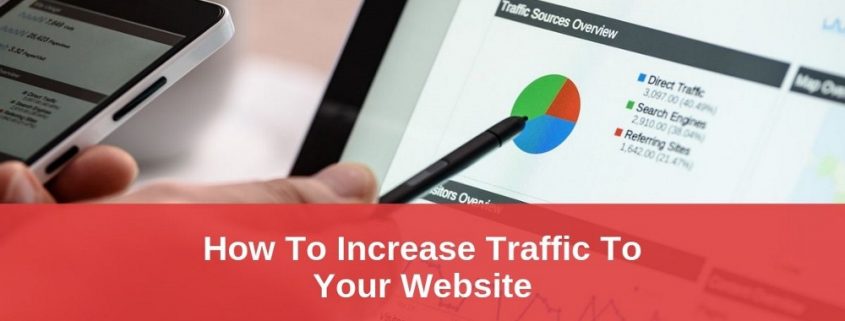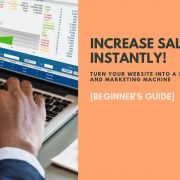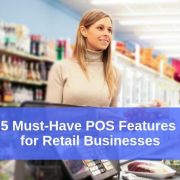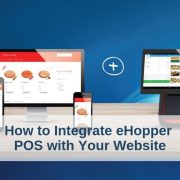How To Increase Traffic To Your Website And Online Store
Traffic is the lifeblood of your website and small business online store. The more website traffic you have, the more opportunities you have for conversion into sales and revenue, or whatever other key metrics you’re striving for.
Without traffic, your small business website won’t gain the attention it deserves and your online store won’t have any visitors making purchases.
In today’s mobile-obsessed, social media-crazy age, nearly every action, strategy or tactic a business performs is, to some level, trying to drive traffic somewhere, typically a website, but sometimes an app, an event, or another place.
If you can master the ability to drive traffic to your website and online store, not only will you have more opportunities to make sales and gain customers, but you’ll also have learned the valuable art of controlling traffic, which can also be used elsewhere to get your customers to act in any number of ways.
In this discussion, we will focus on ten essential steps necessary to increase your website traffic through various digital channels and steps to ensure that your site is optimized and ready to handle an influx of visitors.
Step #1: Build A Presentable, Functioning Website
That famous “Field of Dreams” line, “If you build it, they will come,” only partly applies to websites. It’s not enough to simply build a website anymore and hasn’t been for some time.
You have to create a great site, which means one that is presentable, value-generating, high-functioning and with many other qualities that today’s digital browsers are not just looking for, but expecting. And, if your site under-delivers, today’s visitors will walk out the digital doors of your small business online store instantly.
There are a few things to consider when developing and building your website:
- Design: make sure the site looks presentable, that everything aligns appropriately, and that the colors match your brand image; it’s especially important to consider how this design translates across different devices and screen sizes
- Media: website visitors like a mix of different types of media, such as pictures, videos, graphs, and so on. Don’t rely strictly on text and images
- Functionality: every link, tab, video or other design element needs to function as intended. This is especially important to consider on mobile devices, like smartphones or tablets
- Value: as you are building your site, think about what sort of worth it provides to your customers. Are there tools or resources you can offer visitors that will set you apart from competitors and their websites?
Step #2: Ensure Your Website Is Mobile Friendly
Your website and online store also must be mobile friendly. Mobile is no longer a trend you can ignore. At this stage, even calling it a “trend” undermines the craterous impact that it has had on all aspects of how we communicate and deliver ideas, products, and messages.
To showcase the power that mobile has had on how consumers search and discover new websites and small business online stores, you need only to look at the numbers:
- There are currently 3.5B unique mobile users
- 69% of media consumption occurs on a mobile device
- Mobile is expected to create 80% of all Internet traffic
- Mobile is now the dominant platform for searches; surpassing desktop in early 2016
- The majority (78%) of local business searches result in a purchase
The importance of creating a mobile-friendly site has only grown over recent months, thanks to Google’s announcement of shifting to a mobile-first index. This means that Google will begin to consider the mobile version of web pages as the primary site.
So, if your website isn’t fully functioning on mobile devices, your SEO efforts and rankings could suffer, which means less traffic!
Luckily, in response to their mobile-first initiative, Google has released many helpful guides on becoming mobile friendly.
Step #3: Add SSL Measures To Your Pages
Security is a big concern for any Internet user. We’re practically overloaded with news stories and updates about the latest data breach. Having an identity stolen in today’s Digital Age is becoming just another unfortunate fact of life, like finding out you have a cavity or discovering that someone dinged your car in the grocery store parking lot.
That said, as the concern about data security grows, we develop a greater understanding of how to avoid these issues. For many consumers, that means only shopping and visiting websites and online stores with an SSL certificate.
Having an SSL certificate used to only be a concern for businesses collecting sensitive data, but as concerns about data and personal information security grow, having that extra layer of protection for visitors can help them feel at ease and willing to browse your website.
An SSL certificate is also a powerful booster for your SEO efforts, as it demonstrates your small business website’s authority as a trusted, secure place. Thus, adding this certificate won’t just encourage visitors to stay, it will also help you climb the Google rankings and gain more visibility!
Step #4: eCommerce
Some small businesses fall under this misconception that having an online, e-Commerce store will detract from their physical store’s business. They don’t want their customers shopping online because the in-store experience is better and more valuable to them.
While this is a real concern and potential reality, it doesn’t account for two common behaviors and attitudes held by today’s mobile shoppers.
- People conduct product research, price comparisons, and other searches before visiting a physical store and sometimes while in your store (or a competitor’s shop!)
- Mobile users tend to online shop impulsively and ‘in the now;’ they want immediate convenience
In terms of the first behavior, having an eCommerce platform isn’t strictly about making sales; it’s about connecting visitors with information about the products you sell, your prices, and more.
This empowers the shopper to make smarter purchasing decisions. Even if they don’t ultimately shop at your physical store or small business online store, they’ll appreciate that you did their research and made their buying journey easier.
The second behavior hints at what Google has fittingly called “micro-moments,” or spur of the moment thoughts of ‘I need to buy this,’ ‘I want to know this,’ or otherwise, that result in a search and, sometimes, an immediate purchase.
In these circumstances, people want to access the solution to that question as quickly as possible. If your small business website is there to answer the call, it can be a big win. Plus, these purchases don’t take away from your physical store because these shoppers had little-to-no intention of visiting a store to begin with.
Step #5: Add Value And Content
If you want to increase your website traffic, you need to give your customers and website traffic plenty of reasons to access your web pages and, perhaps more importantly, keep returning to your site. The most common way to build value and encourage visits, especially return visits, is through content, like blogs, tools, and other resources.
Some businesses are misled into believing that the only purpose behind creating content and writing blogs is to stimulate SEO. While this is a significant benefit to creating content, it’s far from the only one.
Content is a great way to showcase your business’s individuality and demonstrate why you’re superior to your competitors. People trust the brands that are more willing to go the extra mile and provide some free value, even if that value is just simple how-to articles or product demonstrations.
For small business online stores that excel at providing value, they will see lots of returning traffic because they’ll have built a reputation as an essential resource for customers, even when that website traffic isn’t expressly interesting in buying products.
Step #6: Google My Business Account
Google My Business has become an essential and practically necessary resource for any small, local business. GMB is a free resource that Google provides. It allows you to create a listing for your business that appears when people do localized searches (“clothing store near me,” “pizza in Houston,” etc.).
Whether you’re trying to encourage visitors to your small business website or your physical store, GMB is an essential resource because it provides convenient support for a lot of crucial information about your business, like your hours, phone number, small business website address and more.
In terms of SEO and improving your website’s visibility, GMB should be your first step. Even if you don’t rank high in the results, a GMB listing can put you near the top of the page! It’s also a wealth of content and value for customers.
Your shoppers can even leave reviews, answer questions about your business, make product recommendations and more. Some consumers will weigh the reputation of a business strictly on their GMB listing and then decide if the website is worth a click.
Step #7: Social Media Accounts
After a Google My Business listing, creating social media business accounts and actively using these platforms is the next crucial step for increasing traffic to your small business website. Why is social media so impactful for website traffic?
Social media is where your customers frequently gather! It’s important to try and grab search traffic, but customers only spend about a fraction of their time browsing the web compared to using social media.
This is especially true of mobile users, who spend 92% of their time inside apps (the majority being Facebook and other social media apps) and only 8% is browsing the web.
By joining social media platforms and getting involved in the conversations taking place there, you’re able to reach and engage customers more frequently than merely waiting for a search or ad campaign to bring them to your doorstep.
Social media is great for building web traffic because you can share any updates or content you’ve posted on your small business website, which can help you gain attention and bring followers in. Plus, social media is designed for sharing content.
When a follower shares your update or sends it to someone, they’re giving you tremendous word-of-mouth marketing potential.
Step #8: Email Marketing Campaigns
Next to social media, email is another important platform, especially when it comes to sending out coupons, notifying people of upcoming sales and events, and re-engaging old customers with exclusive offers.
As such, email is a great client retention tool and helps a business build a one-on-one relationship with a guest through welcome messages, survey requests, purchase thank you notices and other similar tactics. When customers receive email offers, they spend 138% more than guests without these offers.
Email marketing can help you increase traffic by giving customers a reason to visit your site that they didn’t have before. In the same vein as social media, email is beneficial because you’re putting your marketing messages where customers are already gathering — in their email.
Email isn’t intrusive, as customers will willingly sign up for email offers and can choose whether or not to open the messages.
Step #9: Advertise Online
Many of the tactics discussed so far can be performed with little-to-no money, as long as you have the time or staff available to implement them; Google My Business listings and social media accounts are all generally free strategies.
But, if you want to spend a little on generating some website traffic, advertising online, through services like Google Ads or Facebook Ads, is a great idea.
One of the nice features of these advertisement services is that you can accurately target the demographics or types of buyers you’re after.
It’s not the advertise-and-pray mentality that businesses once had to cope with. Thus, the success of your online advertising campaigns can be really strong, primarily if you are targeting the correct audiences.
Facebook Ads, Google Ads, and other services will also show you critical metrics into how effective your campaigns are and how well-received your messages are. You can use these data-born insights to improve future ad campaigns and help ensure that your ROI is in the positive.
Step #10: Integrate Your POS System With Online Store
One of the challenges of creating a small business online store when you already have an existing brick and mortar shop is appropriately tracking inventory across both places.
You don’t want your small business online store to report that you have available stock when the last unit is being sold in-person. Thus, you need to make sure that your inventory is correctly integrated through your point of sale system.

Integrate your POS System with online store
At eHopper, we’re striving to enhance our mobile POS systems with integrative technology to allow businesses to effectively and accurately track their inventory across all physical store locations and online.
This is incredibly important if you have limited stock spread across multiple sites. You want to be able to inform customers where they can get that product and ensure its availability when they get there.
For more information on this exciting update to the eHopper offering, we encourage you to contact us at support@ehopper.com, and we’ll be able to help connect you with the resources to prepare and begin integrating your POS system and online store into a seamless experience that both you and your customers will enjoy and benefit from.









Leave a Reply
Want to join the discussion?Feel free to contribute!